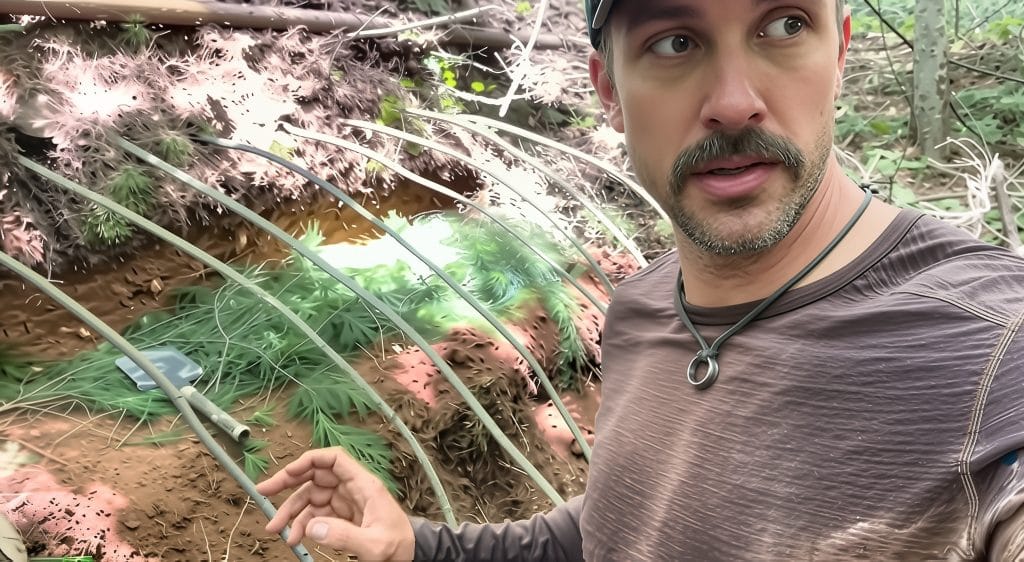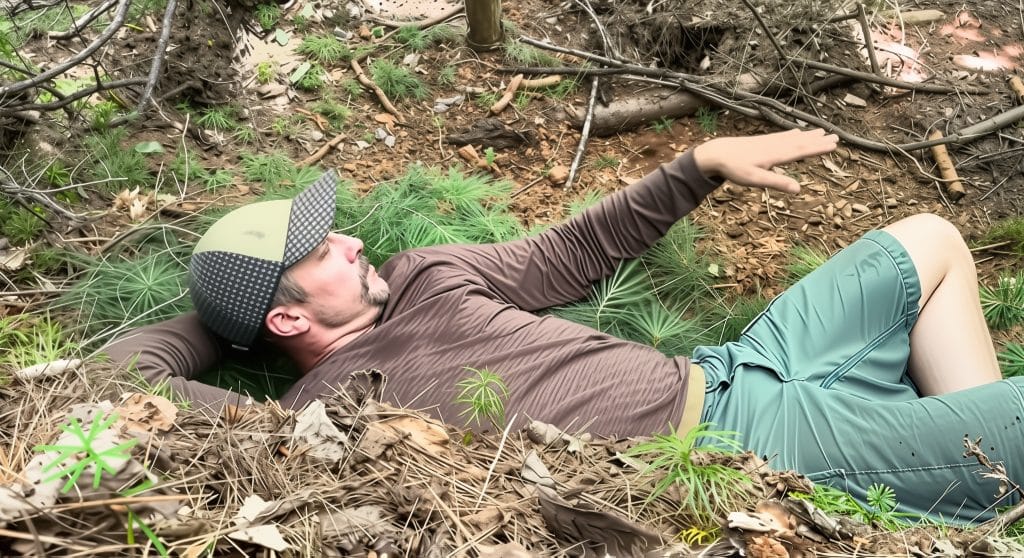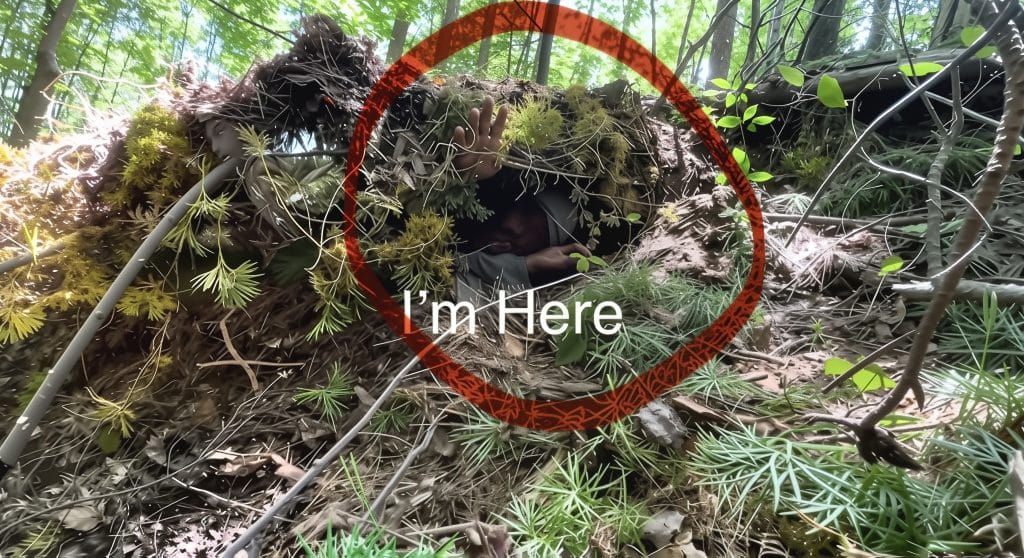
Learn how to build an urban survival shelter using field tested stealth camping techniques. Discover how to disappear in plain sight, build dugout shelters, and live undetected on the edge of civilization.
Last week I found myself crouched in a hillside just yards from a busy road, carving a small dugout into the earth. Most people would have walked right past without ever knowing it was there. The shelter was tucked away just below a line of brush, blended into the terrain so well that a road crew parked fifteen feet away never saw a thing.
This is not the romantic image of wilderness survival. This is the edge. The fringe. The in-between spaces where society hums on one side and silence lives on the other. In a real collapse, this is where most people will be, caught between the city and the wild, trying to disappear while the world keeps spinning.
After years of testing survival tactics in real locations, I’ve learned that effective shelter building is less about gear and more about understanding how to work with the environment, stay unseen, and move like a shadow.
Here’s the truth most people don’t talk about. You are far more likely to need urban survival shelter skills than deep wilderness skills. When disaster strikes, whether from social unrest, economic collapse, or natural disaster, most people won’t be hundreds of miles away. They’ll be on the outskirts of towns, in neighborhoods, or moving through populated areas where stealth matters more than perfection.
According to Federal Emergency Management Agency, the majority of displaced people remain within fifty miles of urban centers. Events like Hurricane Katrina and Hurricane Helene prove again and again that survival happens in populated zones, not deep in the forest.
The techniques I use have been tested near active roads, within earshot of houses, and often while people worked nearby without ever knowing I was there. If it works here, it will work when it counts.

When scouting a site for an urban survival shelter, I’m not looking for comfort or beauty. I’m thinking like someone who needs to stay hidden. That changes everything about how you evaluate ground.
Avoid roads, trails, or clearings that draw the eye.
Use natural terrain features like hillsides, draws, or washes for built-in concealment.
Control sight lines by walking the perimeter before digging.
For this shelter, I went twenty yards off the road into a natural draw. The slope and brush did the work for me. From the road, it looked like untouched ground.
If you are more of a visual learner then watch my Bugout Shelter Video Here: Stealth Shelter So Hidden You'll Walk Right Past It!
I limited myself to a shovel. Simple tools force clear thinking. If you can make it work with the bare minimum, everything else becomes easier.
Step One I stretched out on the ground to mark my footprint. That might sound basic, but too many shelters end up too small or too cramped to actually sleep in.
Step Two I cut into the hillside in layers. Working slowly and removing dirt in thin sheets gives better control and prevents cave-ins.
Step Three I leveled out a small ledge just wide enough for my body and a bit of movement.
Step Four I scattered the excavated soil well away from the shelter and covered it with leaves and pine straw. Ten feet away you couldn’t tell anything had been disturbed.

I built my bed from white pine boughs. They’re soft, springy, and create an insulating barrier between you and the cold earth. In summer, they keep the air moving underneath your body. In winter, they hold warmth.
I harvested the boughs from a small tree about thirty yards from the shelter. All processing happened at the shelter site to avoid leaving multiple signs of activity. Quiet movements. No chopping noise. Just clean, deliberate work.
Good bedding is the difference between a miserable night and actual rest. And real rest is a survival multiplier.
Preparedness isn’t expensive. Regret is.
For less than the cost of one of my checklists you can unlock decades of hard-earned survival experience. I’ve trained elite operators, pushed my own skills to the limit, and tested gear in the toughest conditions. My goal isn’t to impress you. It’s to help you be ready.
Why spend years figuring out what works when I can hand it to you for just $5 a month? Real strategies. Real checklists. Real-world skills from someone who’s lived it.
You can also join for free. On3 Ready Substack
The framework of the shelter was made from irregular deadfall branches. No straight lines. Nature doesn’t build with rulers. Straight edges and clean angles scream human presence.
For cover I used a Mylar emergency blanket. They weigh almost nothing, block rain, and reflect body heat. The problem is shine. So I layered pine branches and ground cover over the Mylar until no reflective surface remained.
In urban and suburban settings, usable materials are everywhere. Cardboard, plastic sheeting, discarded roofing, fabric, and other debris can become excellent shelter cover.
Keep everything low to the ground.
Break up straight lines.
Blend with the natural environment.
Eliminate shine from every angle.
Build away from obvious features that draw attention.
Stillness is just as important as the build itself. Movement draws eyes. Standing motionless in shadows while road crews worked nearby, I was invisible.

Fire is both a blessing and a liability. For heat and water purification, I rely on the Dakota fire hole.
This simple underground system feeds air to the fire chamber through a small tunnel, creating efficient combustion with minimal smoke and no visible flame.
Dig a main chamber and a smaller air hole about eighteen inches away.
Tunnel between them to create an air feed.
Burn dry twigs for nearly smokeless heat.
When done, fill the hole with dirt and remove all trace.
Even with this method, fire should only be used when absolutely necessary.
Urban and suburban environments offer surprising resources if you know how to look. Streams, retention ponds, and rain collection can provide water with proper purification. Hot water tanks in abandoned buildings hold usable reserves.
Food sources can include urban fishing, wild edibles in forgotten lots, fruit trees, dumpster recovery, or scavenging behind restaurants. It’s not glamorous, but survival isn’t about looking good.
Everything in this build was done on my own property. Practicing on land you don’t own can lead to real problems. If you train these skills, do it legally, get permission, or use public lands where it’s allowed.
I also worked to minimize my environmental impact. I scattered soil to make it look untouched. After the experiment, I filled the hole back in and left no trash behind. Respect for the land is part of the skill set.
Heat and humidity can be just as dangerous as cold. In the Georgia summer, I paced myself, worked in shade whenever possible, and left the shelter open for ventilation. In winter, the same shelter would be enclosed with debris for insulation and built deeper to capture ground warmth.
Understanding how to modify a shelter for temperature control is critical for long term survival.

Skills come from repetition. Start with site selection. Build simple shelters with full gear. Then reduce your tools. Time yourself. Spend a night in it. Every round teaches something new.
These skills build real confidence. When everything else fails, you know you can carve a safe place out of the earth.
Building too close to obvious paths or trails.
Leaving piles of dirt and broken vegetation.
Ignoring water flow and drainage.
Failing to blend shelter materials with the surroundings.
Lighting careless fires.
Every mistake increases visibility. The goal is to vanish.
Is it legal to build an urban survival shelter
Yes, on your property or with permission. Regulations vary for public land.
How long can someone live in one of these shelters
Days to weeks depending on water, food, and weather.
What is the biggest risk
Other people. Stealth matters more than the structure itself.
Can it be built in winter
Yes, but digging through frozen ground is slower and requires better insulation.
What tools are needed
A digging tool, cutting tool, cordage, and cover.
How is waste handled
Cat hole latrines about two hundred feet from the shelter and water sources.

Shelter building isn’t just for end of the world scenarios. These skills matter when hurricanes hit, when infrastructure fails, when systems break down.
They matter because they give you options. The ability to disappear in plain sight, to build a shelter that keeps you warm, dry, and secure near populated areas, may be the most practical survival skill you ever learn.
This entire shelter was built twenty yards from an active road. Road crews worked nearby, cars passed, and no one ever knew I was there. That’s the power of blending into the terrain.
Start training now while you still have time to make mistakes. Pick a legal site. Build a shelter. Sleep in it. Learn the lessons before they cost you everything.
Survival happens where people are. Learn to disappear where they least expect it.
About Jason Salyer
Jason Salyer is the creator and host of the ON3 brand. He specializes in practical survival, bushcraft, adventure, and family preparedness. His background includes working as a Division One strength and conditioning coach and a human performance specialist for Naval Special Warfare. His mission is to help families become strong, capable, and resilient.
Explore the gear I personally use and trust.
Wazoo Survival Gear → Shop here (Use code GOON32025 for a discount)
Bear Forest Knives → On3 EDC | On3 Ulu | On3 Primitive
Exotac Fire Starters → Shop here (Code: On3)
PNW Bushcraft Gear → Shop here
Preparation is freedom. Do not wait for the grid to fail to figure out what you should have done. Start now. Train your body, build your get home bag, and learn how to move with confidence when everything else stops.
📩 Substack → On3Ready Newsletter
📺 YouTube → ON Three Channel
🔥 Patreon → Join On Three Community
🌲 Website → GoOn3.com
💪 Fitness → Go On Three Fitness
👕 Apparel → Shop Here

